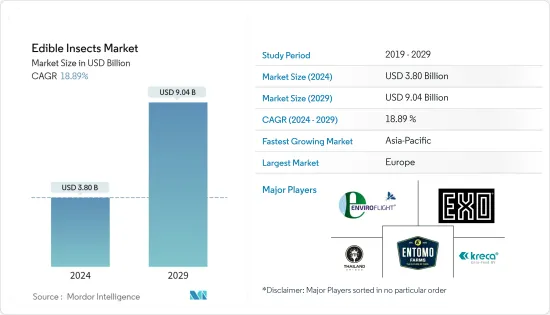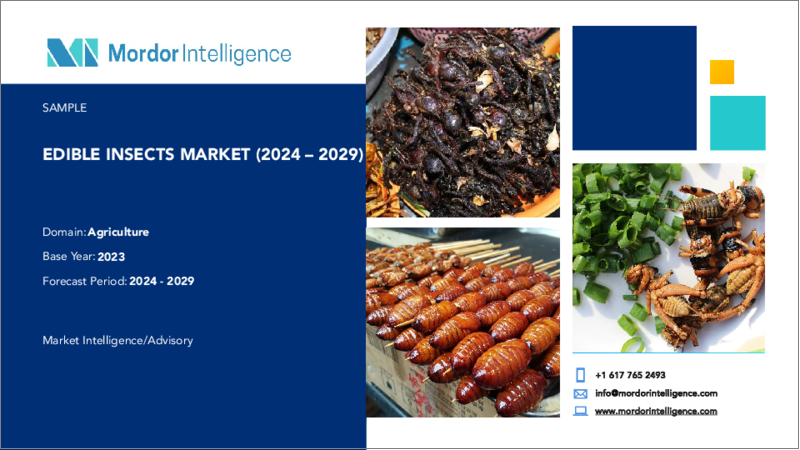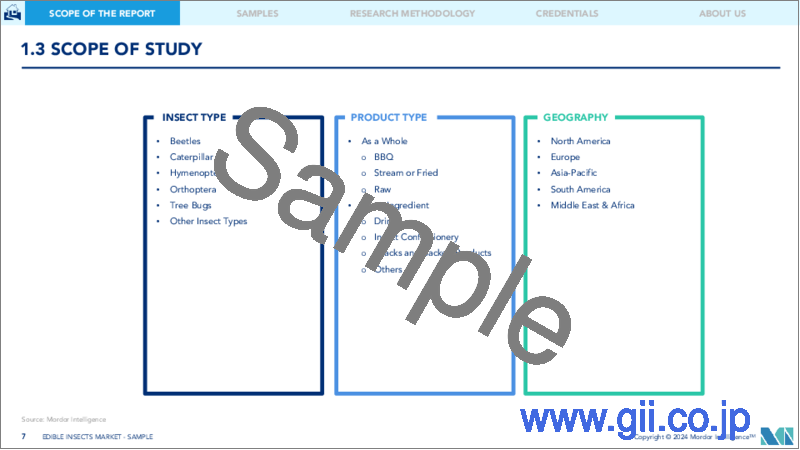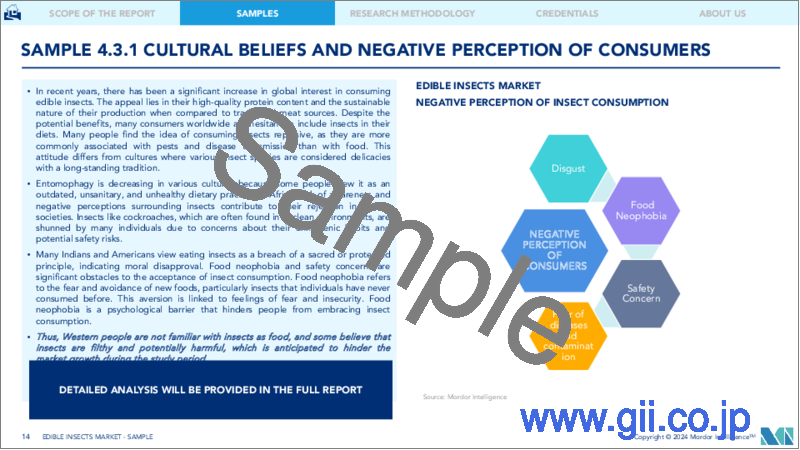|
|
市場調査レポート
商品コード
1444839
可食昆虫:市場シェア分析、業界動向と統計、成長予測(2024~2029年)Edible Insects - Market Share Analysis, Industry Trends & Statistics, Growth Forecasts (2024 - 2029) |
||||||
カスタマイズ可能
適宜更新あり
|
|||||||
| 可食昆虫:市場シェア分析、業界動向と統計、成長予測(2024~2029年) |
|
出版日: 2024年02月15日
発行: Mordor Intelligence
ページ情報: 英文 120 Pages
納期: 2~3営業日
|
- 全表示
- 概要
- 目次
可食昆虫市場規模は2024年に38億米ドルと推定され、2029年までに90億4,000万米ドルに達すると予測されており、予測期間(2024年から2029年)中に18.89%のCAGRで成長します。

主なハイライト
- エントタリアン(昆虫は食べるが他の肉は食べない)は、数年後には世界に存在すると推定される100億人の人々に食料を供給するための問題解決手段として生まれた新しい概念です。昆虫食動物の増加により、世界中で可食昆虫の需要が高まっています。
- さらに、より持続可能で代替の食品や飼料製品を求める消費者の要望により、可食昆虫の使用が徐々に発展しています。たとえば、最近の推定によると、約2,111種の昆虫が約140か国で消費されており、アジア、オーストラリア、アフリカ、南北アメリカなど世界中で昆虫食が記録されており、すでに世界中の人々や家畜によって定期的に消費されています。高たんぱく質、健康的な脂肪、ミネラル、ビタミンの含有量に優れています。
- アジアの熱帯および亜熱帯地域におけるさまざまな昆虫グループの昆虫の消費。昆虫を食べる習慣は栄養面と関連しているだけでなく、社会文化的習慣や宗教的信念とも密接に関連しています。可食昆虫は、豊富なタンパク質源や生態学的に持続可能な地域の食料源で食事を補うためにも使用されます。
- FAO「食品安全の観点から見た可食昆虫」報告書2021年によると、食品および飼料のサプライチェーンにおける昆虫の生産と商業化を管理するために、各国で可食昆虫に関する規制の枠組みがいくつか存在します。たとえば、2020年の米国では、可食昆虫、昆虫の部分、または派生物の食品使用は、米国食品医薬品局(FDA)の監督の範囲内になります。したがって、可食昆虫および昆虫ベースの食品は、連邦食品・医薬品・化粧品法(FD&C法)およびその施行規則に準拠する必要があります。たとえば、昆虫および昆虫派生物を食品または着色料添加物として使用する場合、これらの使用はFDAの承認を受ける必要があります。
- 多くの政府機関は、可食昆虫ビジネスを世界的に拡大するための投資、調査、業界パートナーに重点を置く多数のプロジェクトや取り組みを開発しています。たとえば、2022年 10月、オーストラリア国際農業研究センター(ACIAR)は、アグリフューチャーズオーストラリアおよび国際昆虫生理学・生態学センター(ICIPE)と協力して、オーストラリアに新しい調査拠点を立ち上げました。昆虫を人間の食品、動物飼料、肥料、石油などの製品として使用する産業。
可食昆虫市場動向
入手が容易でタンパク質含有量が高い可食昆虫
可食昆虫は市場での入手しやすさと手頃な価格が高いです。それらは簡単に栽培、入手でき、さまざまな形または全体として添加物として毎日の食事に組み込むことができ、それによって食品の全体的な栄養価を高めることができます。さらに、これらの昆虫は収穫後の加工作業が最小限で済むため、動物由来の肉製品に代わる非常に経済的な代替品となります。
可食昆虫の中で、最大の量を占めるのは甲虫です。昆虫はアミノ酸とタンパク質の持続可能な供給源です。オメガ3、ミネラル、食物繊維、脂肪酸も豊富です。この昆虫は、鉄、亜鉛、マグネシウム、マンガン、リン、セレンなどの微量栄養素の優れた供給源であることも判明しました。可食昆虫に含まれるビタミンには、リボフラビン、パントテン酸、ビオチン、場合によっては葉酸が含まれます。複数の栄養要素があるため、昆虫は食品および飲料業界に急速に追加されています。持続可能な実践への動向の変化により、今後数年間で市場が押し上げられる可能性があります。
FAOが実施した食品安全の観点からの可食昆虫に関する調査報告書2021では、既知の可食昆虫種の92パーセントが野生で収穫され、6パーセントが半家畜化され、2パーセントが養殖されていると述べられています。野生で採取される既知の可食昆虫種のうち、88パーセントは陸生であり、残りは水生生態系から収集されます。最近、他のいくつかの昆虫種が集中的に養殖されています。
欧州が市場を独占
欧州は引き続き世界の可食昆虫市場を独占しています。可食昆虫市場への関心が高まっているのは、欧州諸国におけるタンパク質が豊富な食品への需要の高まりとタンパク質源の消費の多様化によるものです。可食昆虫および昆虫ベースの食品分野は、意識向上活動と欧州の規制の発展により、最近、生産および取引される量が増加しています。 FAOによると、昆虫は世界中で20億人以上の人々の食事の一部となっています。現在、可食昆虫は西洋社会のニッチ市場を代表しています。しかし、私たちの食生活が急速に変化し、昆虫を使った食品を試してみたいという消費者の意欲が高まっているため、昆虫養殖は欧州で成長産業となっています。
欧州市場で可食昆虫への関心が高まっていることを背景に、一定の国家政策への注目と迅速な規制対応が生まれました。欧州連合(EU)では、昆虫全体とその成分は、新規食品に関する規制(EU)No 2015/2283(または「新しい」新規食品規制)に含まれています。この規制は2018年 1月1日に発効し、EU市場全体でこれらの製品を商品化する前に市販前の認可が必要となります。
欧州市場に投入される昆虫ベースの製品(昆虫全体、昆虫成分、および可食昆虫が組み込まれた製品)の生産の獲得、マーケティングチャネルへの巨額投資、および消費の増加は、いくつかの要因によって推進されています。新しい食品としての昆虫、市場に出回っている製品の多様性、製品の入手可能性(小売店での入手可能性など)、および消費者の受け入れは、今後数年間に可食昆虫市場を押し上げる重要な要素の一部です。
可食昆虫業界の概要
調査で紹介された企業によると、ほとんどの企業は調査対象市場に新規参入しており、市場シェアのほんの一部しか保有していないため、可食昆虫市場は非常に細分化されています。 Exo Inc.、Thailand Unique、Entomo Farms Ltd.、Kreca Ento-Feed BV、Enviro Flight LLCなどは、可食昆虫市場で大きなシェアを占める著名な企業です。製品イノベーションと新製品の発売は、調査対象の市場のプレーヤーの間で最も人気のある市場戦略の1つです。主要企業は主に、増え続ける需要に対応し、市場での存在感を維持するために、研究開発への投資と生産能力の強化に重点を置いています。
その他の特典
- エクセル形式の市場予測(ME)シート
- 3か月のアナリストサポート
目次
第1章 イントロダクション
- 調査の前提条件と市場の定義
- 調査範囲
第2章 調査手法
第3章 エグゼクティブサマリー
第4章 市場力学
- 市場概要
- 市場促進要因
- 市場抑制要因
- ポーターのファイブフォース分析
- 買い手の交渉力
- 供給企業の交渉力
- 新規参入業者の脅威
- 代替製品の脅威
- 競争企業間の敵対関係の激しさ
第5章 市場セグメンテーション
- 昆虫タイプ
- 甲虫
- 芋虫
- 膜翅目
- 直翅目
- 半翅目
- その他の昆虫タイプ
- 製品タイプ
- ホール
- バーベキュー
- スチームまたはフライ
- 生
- 原料
- ドリンク
- 昆虫菓子類
- スナックおよびバック商品
- その他
- ホール
- 地域
- 北米
- 米国
- カナダ
- メキシコ
- その他北米
- 欧州
- ドイツ
- 英国
- フランス
- ロシア
- ポーランド
- その他欧州
- アジア太平洋
- 中国
- 日本
- タイ
- その他アジア太平洋地域
- 南米
- ブラジル
- アルゼンチン
- その他南米
- 中東とアフリカ
- 南アフリカ
- 残りの中東とアフリカ
- 北米
第6章 競合情勢
- 最も採用されている戦略
- 市場シェア分析
- 企業プロファイル
- Thailand Unique
- Nordic Insect Economy Ltd.
- Kreca Ento-Feed BV
- Entomo Farms Ltd.
- Exo Inc.
- Proti-Farm
- Enviro Flight LLC
- Bugsy Bros
- Deli Bugs Ltd.
- Eat Grub Ltd
第7章 市場機会と将来の動向
The Edible Insects Market size is estimated at USD 3.80 billion in 2024, and is expected to reach USD 9.04 billion by 2029, growing at a CAGR of 18.89% during the forecast period (2024-2029).

Key Highlights
- Entotarians (one whose diet includes insects but no other meats) is a novel concept that came into existence as a problem solver to feed the estimated 10 billion people that the world will have in some years. The growing number of entotarians has intensified the demand for edible insects worldwide.
- In addition, due to consumer desire for more sustainable and alternative food and feed products, the use of edible insects has been gradually developing. For instance, according to recent estimates, approximately 2,111 species of insects are consumed in about 140 countries, with entomophagy documented around the world like in Asia, Australia, Africa, and the Americas are already consumed regularly by people and domestic animals across the globe owing to their high protein, healthy fat, mineral, and vitamin content.
- The consumption of insects in the tropical and sub-tropical Asian regions from various insect groups in these regions. Insect-eating habits are not only associated with nutritional aspects but are also closely related to socio-cultural practices and religious beliefs. Edible insects are also used to complement diets with rich protein sources and ecologically sustainable sources of the region's food.
- According to the FAO Edible Insects from a Food Safety Perspective, Report 2021, there are some regulatory frameworks for edible insects in distinct countries to govern the production and commercialization of insects in food and feed supply chains. For instance, in the United States, in the year 2020, the food uses of edible insects, insect parts, or derivatives fall within the oversight of the United States of America Food and Drug Administration (FDA). As such, edible insects and insect-based food products must comply with the Federal Food, Drug, and Cosmetic Act (FD&C Act) and its implementing regulations. For example, if insects and insect derivatives are to be used as food or color additives, these uses must be approved by the FDA.
- Many government associations are developing numerous projects and initiatives to focus on investments, research, and industry partners to escalate the edible insects business globally. For instance, in October 2022, the Australian Centre for International Agricultural Research (ACIAR) collaborated with AgriFutures Australia and the International Centre for Insect Physiology and Ecology (ICIPE) to create a new research hub launched in Australia, which derives the emerging insect technology with industries using insects as human food, animal feed, fertilizer and other products such as oil.
Edible Insects Market Trends
Easy Availability and High Protein Content in The Edible Insects
The accessibility and affordability of edible insects are high in the market. They can be easily cultivated, procured, and incorporated into the daily diet as additives in various forms or as a whole, thereby enhancing the overall nutritional quality of the food. In addition, these insects exhibit minimal processing operations during post-harvest, thus providing a highly economical alternative to animal-based meat products.
Among the edible insects, beetles constitute the largest volume share. Insects are sustainable sources of amino acids and proteins. They are also rich in Omega-3, minerals, dietary fiber, and fatty acids. The insects were also found to be good sources of micronutrients like iron, zinc, magnesium, manganese, phosphorus, and selenium. The vitamin content in edible insects includes riboflavin, pantothenic acid, biotin, and, in some cases, folic acid. Due to multiple nutritional elements, insects are rapidly added to the food and beverage industry. The shifting trend towards sustainable practices will likely push the market in the coming years.
A study conducted by FAO Edible Insects from a Food Safety Perspective Report 2021 stated that 92 percent of known edible insect species are wild-harvested, 6 percent are semi-domesticated, and 2 percent are farmed. Among the known wild-harvested edible insect species, 88 percent are terrestrial, and the remaining are collected from aquatic ecosystems. Recently, some other insect species have been farmed intensively; for instance, the industrialized production of house crickets (Acheta domesticus) in the United States of America mainly for pet food and fishing bait (Morales-Ramos et al., 2020).
Europe Dominates the Market
Europe continues to dominate the global edible insects market. The growing interest in the edible insect market is due to the growing demand for protein-rich food and the diversification of protein sources consumption in European countries. The edible insect and insect based-food sector has recently increased in the quantities produced and traded owing to awareness-raising actions and the development of European regulations. According to the FAO, insects are part of the diet of more than two billion people around the world. Currently, edible insects represent a niche market in western societies. However, insect farming is a growing industry in Europe as our dietary habits are rapidly changing and the willingness of consumers to try insect-based food is increasing.
In the context of the growing interest in edible insects on the European market, certain national policy attention and prompt regulatory response were generated. In the European Union (EU) whole insects and their ingredients are included under Regulation (EU) No 2015/2283 on novel foods (or the 'new' novel food regulation). The Regulation came into force on 1st January 2018 and requires pre-market authorizations before commercializing these products across the EU market.
Gaining production of insect-based products (whole insects, insect ingredients, and products incorporated with edible insects) placed on the European market, massive investments for the channel in marketing, and increase in consumption is driven by several factors, notably the expected authorization of insects as a novel food, the diversity in products on the market, availability of the product (e.g. availability in retail outlets) and the consumers' acceptance are some of the essential factors boosting the edible insects market during the coming years.
Edible Insects Industry Overview
The edible insects market is highly fragmented, as most companies are new in the market studied and hold only a tiny fraction of the market share, as per the companies profiled in the study. Exo Inc., Thailand Unique, Entomo Farms Ltd., Kreca Ento - Feed BV, and Enviro Flight LLC are some prominent companies that account for a significant share of the edible insect market. Product innovations and new product launches are among the most popular market strategies among the players in the market studied. The significant players primarily focus on investing in R&D and enhancing their production capacities to cope with the ever-increasing demand and stay relevant in the market.
Additional Benefits:
- The market estimate (ME) sheet in Excel format
- 3 months of analyst support
TABLE OF CONTENTS
1 INTRODUCTION
- 1.1 Study Assumptions and Market Definition
- 1.2 Scope of the Study
2 RESEARCH METHODOLOGY
3 EXECUTIVE SUMMARY
4 MARKET DYNAMICS
- 4.1 Market Overview
- 4.2 Market Drivers
- 4.3 Market Restraints
- 4.4 Porter's Five Forces Analysis
- 4.4.1 Bargaining Power of Buyers
- 4.4.2 Bargaining Power of Suppliers
- 4.4.3 Threat of New Entrants
- 4.4.4 Threat of Substitute Products
- 4.4.5 Intensity of Competitive Rivalry
5 MARKET SEGMENTATION
- 5.1 Insect Type
- 5.1.1 Beetles
- 5.1.2 Caterpillar
- 5.1.3 Hymenoptera
- 5.1.4 Orthoptera
- 5.1.5 Tree Bugs
- 5.1.6 Other Insect Types
- 5.2 Product Type
- 5.2.1 As a Whole
- 5.2.1.1 BBQ
- 5.2.1.2 Stream or Fried
- 5.2.1.3 Raw
- 5.2.2 As a Ingredient
- 5.2.2.1 Drinks
- 5.2.2.2 Insect Confectionery
- 5.2.2.3 Snacks and Backed Products
- 5.2.2.4 Others
- 5.2.1 As a Whole
- 5.3 Geography
- 5.3.1 North America
- 5.3.1.1 United States
- 5.3.1.2 Canada
- 5.3.1.3 Mexico
- 5.3.1.4 Rest of North America
- 5.3.2 Europe
- 5.3.2.1 Germany
- 5.3.2.2 United Kingdom
- 5.3.2.3 France
- 5.3.2.4 Russia
- 5.3.2.5 Poland
- 5.3.2.6 Rest of Europe
- 5.3.3 Asia-Pacific
- 5.3.3.1 China
- 5.3.3.2 Japan
- 5.3.3.3 Thailand
- 5.3.3.4 Rest of Asia-Pacific
- 5.3.4 South America
- 5.3.4.1 Brazil
- 5.3.4.2 Argentina
- 5.3.4.3 Rest of South America
- 5.3.5 Middle-East & Africa
- 5.3.5.1 South Africa
- 5.3.5.2 Rest of Middle-East & Afric
- 5.3.1 North America
6 COMPETITIVE LANDSCAPE
- 6.1 Most Adopted Strategies
- 6.2 Market Share Analysis
- 6.3 Company Profiles
- 6.3.1 Thailand Unique
- 6.3.2 Nordic Insect Economy Ltd.
- 6.3.3 Kreca Ento - Feed BV
- 6.3.4 Entomo Farms Ltd.
- 6.3.5 Exo Inc.
- 6.3.6 Proti - Farm
- 6.3.7 Enviro Flight LLC
- 6.3.8 Bugsy Bros
- 6.3.9 Deli Bugs Ltd.
- 6.3.10 Eat Grub Ltd






